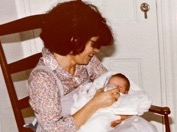When my daughter Zoe came to visit with 5 month-old Zach, my first grandchild, we looked together through the photo album I’d made of her first year. In it we found a picture of me feeding her in the very same rocker in which she liked to sit feeding her baby. Nothing had changed. And yet, at the same time, it seemed that almost everything about childcare is different. I remember young parenting as so much easier, simpler. Zoe is armed against dangers my generation never imagined. Could the world have changed that much?
In the delivery room, right from the start, Zach was fitted with an ankle cuff to guard against kidnapping. The cuff had to be double checked and removed before his parents could take him home, just like the security buttons on expensive clothing and electronics. And he couldn’t leave the hospital without a car seat of specified construction, a thick, heavy, plastic shell padded like the protective crash seat it is meant to be. Forty years earlier, we’d carried Zoe out—and home—in our arms.
Zach’s carseat snapped into a stroller of impressive construction. When Zoe was an infant and no longer traveling in the papoose I wore on my chest, she rode in a fabric sling attached to a light metal frame, an “umbrella stroller” that could collapse and hang from my arm. When our son arrived, I got a double wide version in which I blithely pushed my toddlers off the curb and into the street without a second thought. It never occurred to me that the cars wouldn’t stop for us.
Of course, like all mothers today, Zoe never put Zach to sleep face down, as I did her, because we now know that to do so risks SIDS (Sudden Infant Death Syndrome). As a result, since Zach couldn’t practice pushing up from his mattress he had daily “tummy time”—which he hated—to build his arm muscles and wore a special cap to keep his skull from flattening because he was always on his back. The cap didn’t work, and he ended up being fitted for a custom corrective helmet to help reshape his soft skull.
On a form provided by the pediatrician, Zoe tracked Zach’s growth, recording everything he took in—and put out. She and her husband followed instructions to time each feeding carefully, getting up to wake the baby for his midnight feed. They “sleep-trained,” helping Zach to “self-soothe” and to regulate his sleep pattern. Bottles of hand sanitizer were scattered about to use before picking him up. Zach’s swim clothes, floaties, and little beach tent were UV protected, even his tiny water booties. He slept under his crib’s mosquito netting. Certainly, we’d been ignorant about the risks of SIDS and UVs, but we were wrong about everything else?
Pediatricians I’ve spoken to tell me the new generations’ protective vigilance is a recent phenomenon and has several explanations. It’s attributed to the wide availability of the latest research on the internet, to the market’s response to the new data, and to the sense of living in an increasingly dangerous world. But I can’t help but worry about all the anxiety it must arouse, about the pressure it puts on young parents and indirectly on the children. Are new parents today undermining their children’s resilience? Are they being alarmist?
In my mind’s eye, we were so carefree. With our flowing hair, in our tie-dyed bellbottoms, we pursued the natural. We let our babies get dirty and make messes. We fed on demand and accommodated to their sleep patterns. We followed where our babies led.
But, if truth be told, looking harder into the photos in Zoe’s baby book, I can see the anxiety behind my smile. A baby’s vulnerability and complete dependance are alarming. My generation became parents when psychologists were delving into cognitive development and studying issues like the importance of gender equality and the value of play. We read the new books and carefully followed the authors’ advice. We stimulated our babies’ little minds, dressed our girls in overalls, and gave our sons dolls instead of guns. We believed that if you did everything right you could raise happy, mentally-healthy children equipped to fulfill their potential. Ours was a new and improved version of parenting. But so much hung on our enlightened approach, it was overwhelming—and frightening. We could so easily fail!
New parents of newborns are as fledgling as their charges, feeling most clueless when their infants are at their most helpless. We hold to what the experts prescribe as to a lifeline. The advice is new and may prove to be well-founded. It’s too soon to know if the line between too much and too little is in just the right place. And it may be different for each family, in any case.
More important are the things that never do change: the wish to be the best parents we can, the deep fear, the indescribable joy.

Long ago I read that Jane Austen, who, of course, had no children wrote, “you don’t know what fear is until you’ve had a child”. So it’s a universal truth?
But I’ve googled the phrase and I’ve diligently searched through pages and pages of Austen quotes to no avail.
Did I make it up?!?
What a great line. I’ve never heard it, but I think it is a universal truth. As for Austen getting credit for it, that probably was a mistake. If you think you might have made it up, good for you! I’ll give you credit whenever I repeat it!
Fascinating read, even for those of us with cats instead of kids.
Love the cats and kids. So you!